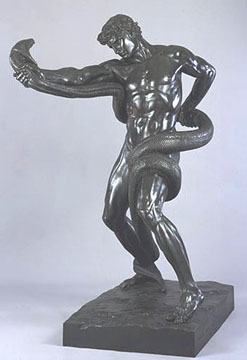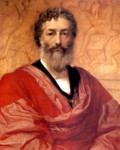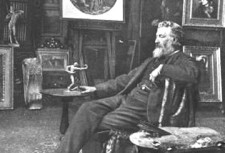

Frederic Leighton
English, 1830-1896
An Athlete Wrestling with a Python, 1877 modelled; 1903 cast
bronze
20 1/2 × 14 × 11 in.
SBMA, Museum purchase, with funds provided by Lord and Lady Ridley-Tree
1997.45

Self portrait of Lord Leighton, 1880, Galleria degli Uffizi,Florence, Italy
RESEARCH PAPER
Frederic Leighton was primarily a painter and a very successful one during his life time. The very first painting he exhibited at the Royal Academy in London was bought by Queen Victoria. He was elected to the Academy as an associate in 1864 and as a full member in 1868. He was its president for 12 years and was the first artist to be elevated to the peerage. It is ironic that despite his prodigious output as a painter, his most significant contribution to art was through sculpture. During his long career he produced only three sculptures, one of which, Athlete Strangling a Python , is in our collection at Santa Barbara Museum of Art.
Although Leighton's painting output included landscapes, portraits, genre paintings and classical subjects, he was best known for his masterly figure paintings which he infused with vibrant sensuality. His gorgeously costumed figures were painted with a flare and skill which reflected his many years of training.
Leighton's life was as interesting as his art. He was born into a well-to-do English family with a cosmopolitan outlook. His grandfather, a society doctor, emigrated to St. Petersburg and became the Tsarina's physician. His father worked in St. Petersburg before studying medicine in Edinburgh and Paris. He and his sisters were tutored by their intellectual father as the family moved from France to Switzerland, and on to Germany and Italy. The combination of material comfort and continental sophistication gave him a naturally aristocratic bearing and his father's rigorous expectations spurred him on to prove himself.
From his early youth Frederic showed a talent for drawing when, as a nine year old with scarlet fever, he turned to sketching as an outlet. He was first allowed to study drawing when the family spent the winter of 1841 in Italy and continued in Berlin the following year and then in Florence. His drawings show that he was a natural draughtsman throughout his career. Leighton's father considered art to be more a hobby than a career and discouraged the idea of Frederic's becoming an artist unless he could be eminent at it. However, when the elder Leighton showed some of Frederic's drawings to the American sculptor, Hiram Powers, for his opinion, Powers said that nature had made Frederic an artist already.
Leighton's studies did not begin formally until the family moved to Frankfurt in 1846 where he enrolled in the Städelsches Kunstinstitut, the city's principal art institute and a focus for German Nazarene principles of the eternal truth of life and art. Later he studied with Edward von Steinle, a history painter who imparted his ideals of tradition, seriousness and discipline in art. There he finished several large historical canvases. When his training was completed in 1852, he spent two years in Italy where he began work on a large-scale painting of a procession carrying Cimabue's Madonna which was accepted by the Royal Academy, praised by Ruskin and bought by Queen Victoria as a gift for Prince Albert who had admired it.
When Leighton first settled in London in 1859, he was determined to become a leading painter of historical, literary and biblical subjects. He recognized that the Royal Academy was the ideal forum for his ambitions, but it took nine years before he achieved full membership. He suffered a certain amount of prejudice for his continental style of painting and personal manner. However, his paintings were so successful that he could not be denied membership.
Leighton's painting began to change subtly beginning with the 1860's. He became acquainted with some of the younger painters of the day including Pre-Raphaelites and began to believe that to instill an abstract quality of beauty was the sole objective of art. Artists of the time were beginning to try to express the meaning of their paintings without narrative content. Leighton's La Nanna portraits of 1858-9 gave no narrative clues as to how the model was to be regarded and may have been an inspiration to other artists of the day. A powerful classical influence came over English art in the '60's, a movement of which Leighton was a leading figure. His second great processional painting, The Syracusan Bride , contains numerous figures clothed in rhythmic patterns of drapery similar to that of classical sculpture. The third influence on Leighton's painting of the '60's was a new interest in themes of a languorous and erotic character. Leighton began to paint both male and female nudes and draped female figures in total abandonment.
One of his most famous paintings, Flaming June , was exhibited at the Royal Academy in 1895, one year before his death. It combines the languid escapism of the 1890's with the classicism one would expect from the president of the Royal Academy. The sleeping figure has the translucent and animate draperies of classical Greek sculpture and the fullness of modeling and accurate detail to make it respectable. However, the shades of orange and apricot of the drapery and the oleanders summoning a balmy Mediterranean climate convey a summer mood of erotic longing.
Throughout his life Leighton remained dedicated to art and beauty. He never married, saying that he was married to his art. As president of the Royal Academy and possessed of the gifts of being a natural leader, intellectual and orator, he became a force in the national and international art world. He was a founder of the Venice Biennale in 1895. He rose to the status of "celebrity" in a golden age of gentlemen artists. His public life completely eclipsed his private life. He was a member of as many as ten gentlemen's clubs, but usually dined alone at the Athenaeum around the corner from the Royal Academy. He was very generous with his wealth, derived both from his painting and inheritance. He helped many aspiring young painters as well as the families of some of his models. He also contributed to a large number of charities. He was a founder of the Kyrle Society whose purpose was to create and inspire beauty among the masses. He was also commanding officer in the 20th Middlesex Volunteer Corps (the Artists' Rifles, as it is better known).
The artist's home, Leighton House, which he had built in 1864, gives some insight into his daily life. He called it a studio-house and it was created to welcome his public, with many reception rooms. The house was furnished with luxurious fabrics, wallpapers and art objects in the pursuit of beauty. It was a public display as well as salesroom and workshop. The spirit of the house conveyed beauty, art and entertainment. He was the perfect host at his annual parties, where he would lavishly entertain his distinguished guests - among them the Prince of Wales. There was nothing domestic about the house. In fact, there were no guest rooms as visitors might distract Leighton from his work. His butler managed his busy schedule and screened visitors who were admitted only by appointment. He worked from 9 a.m.-noon and 1-5 p.m. Sunday afternoons were reserved for visitors and musical entertainments, often held in his first floor studio. In keeping with the principles of the Kyrle Society, he built an addition to his house, the Arab Hall between 1877-79. It was a synthesis of contemporary craft work, design, material and authentic tiles created by Leighton as something beautiful to look at once in a while. Though often used by the owner as a gentlemen's smoking room, it was also open to the public.
Of all his many accomplishments, perhaps his most enduring is his influence on sculpture in Britain in the last quarter of the nineteenth century. His life size bronze figure, An Athlete Wrestling with a Python , when shown at the Royal Academy in 1877, was acclaimed as a milestone in British sculpture. What made this achievement the more remarkable was that in his whole career, he only produced three fine art sculptures and had no reputation at all as a sculptor. Leighton had been in the habit of modeling small figures as an aid in working out the composition of his paintings. The Athlete began as such an exercise, the subject for this bronze grew out of work on his painting Hercules Wrestling with Death for the Body of Alcestis (Wadsworth Athenaeum). The original plaster model, about ten inches tall was made in 1874. Leighton showed it to French sculptor, Jules Dalou, who urged him to enlarge it. Although the Athlete has no mythological identity, it has a French Neoclassic ancestor in a statue by Bosio of Heracles Fighting Acheloüs in the Form of a Serpent . Leighton almost certainly was familiar with this sculpture, but all he took from it was the idea of man fighting a serpent and perhaps the extended right arm gripping the animals neck. He also drew on classical sources like the Laocoön for this powerful and complex design. (Laocoön and his sons were crushed to death by two serpents sent by Apollo as divine punishment for committing sacrilege in the temple).
For its time, the Athlete was as bold a venture into new territory in Britain as Rodin's Age of Brass , exhibited in the same year, was in France. What distinguished the Athlete was its extraordinary sense of physical action and the naturalness with which the body was portrayed without consideration for ideal beauty (with the exception of the head which is reminiscent of Michelangelo's David ). The striking realism of the anatomy and the surface detail was something new in English sculpture. The Athlete brought Leighton a gold medal at the Paris International Exposition of 1878.
In this, as with all bronze casts, the quality of the cast, the chasing, and the patina are of primary importance. This example is superlative in quality.
The death of Frederic Leighton in 1896 was considered a national loss. As a painter, he was a superb draughtsman, colorist, and modeler, as a patron of the arts, he was an intellectual and generous leader, as a sculptor, his work remains a milestone in the history of 19th Century English art.
BIBLIOGRAPHY
Bailey, Kate. "Leighton-Public and Private Lives, Celebrity and the Gentleman Artist." Apollo , February 1996, 22-26.
Jones, Stephen et al. Frederic, Lord Leighton, Eminent Victorian Artist . London: Harry N. Abrams, Inc., with Royal Academy of Arts, 1996.
Lambourne, Lionel. The Aesthetic Movement . London: Phaidon Press Limited, 1996.
Read, Benedict. "Leighton as a Sculptor, Releasing Sculpture from Convention." Apollo , February 1996, 65-69.
Rosenblum, Robert and Janson, H. W. 19th-Century Art . New York: Harry N. Abrams, Inc., 1984.
Prepared for the Santa Barbara Museum of Art Docent Council by Betsy Northrop, February, 1998
Additional information included from docent file cabnet, written by Robert Henning while Chief Curator at SBMA.
Edited and prepared for the SBMA Docent website by Loree Gold, 2008

1st Baron Leighton of Stratton, in his studio comtemplating the Athlete. Albumen print, 1890, owned by the SBMA
SBMA CURATORIAL LABELS
This is a smaller version of Leighton’s first major sculpture, now at the Tate Britain. The dynamic nude figure of the athlete battling a snake is likely influenced by the well-known ancient sculpture group known as the Laocoön, which features powerful, dynamic nude male forms fighting a snake. Leighton’s sculpture pairs a similarly dynamic pose with a theme drawn from antiquity and a highly detailed, naturalistic approach to the human body. The Athlete was so popular when it was first displayed in 1877 that it led to a movement—called the New Sculpture by critics—and a sharp increase in interest in sculpture in Britain, particularly in public works projects.
- A Legacy of Giving, 2024
Leighton, a painter, cast only three bronzes over his long career but regularly made rough clay models, called "esquisses", as preparation for his paintings. A French sculptor, perhaps Alphonse Legros or Aimé-Jules Dalou, while visiting Leighton’s home-studio, encouraged him to enlarge and cast a version of the athlete in bronze. The life-size bronze premiered at London’s Royal Academy in 1877 and met with instant critical acclaim, sparking the art movement called New Sculpture. Collectors clamored for examples, commissioning pieces in bronze and marble. Because of the reusability of molds, reproductions could be made. Tools like proportional calipers or a pointing machine enabled studio assistants to enlarge or reduce pieces with considerable precision, long before the magic of lasers or 3D printing. In the 1890s, Leicester Galleries of London commissioned Leighton to make this table-top-sized edition.
- Fire Metal Monument: Bronze, 2021
Frederic Leighton’s "Athlete Wrestling with a Python" became a clarion call for the modernization of sculpture in England when the life-size bronze version of this subject was exhibited at the Royal Academy in 1877. The sculpture invites the viewer to move around it in a circle, not unlike the coils of the snake around the athlete. Persuasive described details such as the scales of the reptile, and the bulging veins of the man are calculated to engage our imagination in the ongoing battle.
- Sculptures that Tell Stories, 2019
Leighton exhibited a life-size bronze version of this subject at the Exposition Universelle in Paris in 1877. Known primarily as a history painter, somewhat in step with the Pre-Raphaelites, this was his first attempt at ambitious sculpture. The statue was immediately hailed by critics as one of the outstanding, modern reinterpretations of the classical staple of the male nude. Meant to rival such canonical antique precedents as Laocoön and His Sons, Leighton’s athlete is shown at the moment of greatest tension, as he struggles to subdue the outsized serpent. The passionate drama of this pitting of man and monster signaled a decisive break with the more austere treatments favored by earlier 19th-century sculptors such as Antoine Barye, whose Theseus and the Minotaur is on view nearby.
- Rodin and His Legacy, 2017
